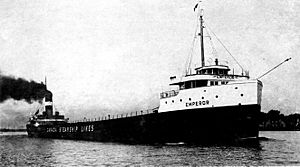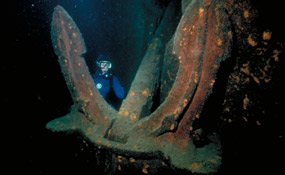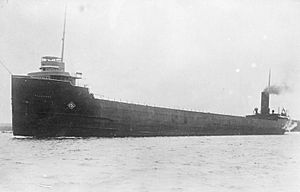SS Emperor facts for kids

The Emperor in the St. Marys River
|
|
Quick facts for kids History |
|
|---|---|
| Name | Emperor |
| Operator | Canada Steamship Lines Ltd. |
| Builder | Collingwood Ship Building Co. |
| Launched | December 17, 1910 |
| In service | May 3, 1911 |
| Out of service | June 4, 1947 |
| Fate | Sunk off the shore of Isle Royale in Lake Superior |
| General characteristics | |
| Type | Freighter |
| Tonnage | 4641 tons |
| Length | 525 ft (160 m) |
| Beam | 56 ft (17 m) |
| Depth | 27 ft (8.2 m) |
| Installed power | 1,500 horsepower |
| Propulsion | triple expansion steam engine |
| Speed | 10 knots |
| Notes | Registry #126,654 |
|
EMPEROR
|
|

The Emperor's anchor
|
|
| Location | North side of Canoe Rocks, on northeast end of Isle Royale National Park, Michigan |
| Area | 91.8 acres (37.2 ha) |
| Built | 1910 |
| Architect | Collingwood Ship Building Co. |
| Architectural style | Freighter |
| MPS | Shipwrecks of Isle Royale National Park TR |
| NRHP reference No. | 84001748 |
| Added to NRHP | June 14, 1984 |
The Emperor was a large cargo ship, also known as a freighter. It was built in 1910 and sadly sank in 1947. This happened off the coast of Isle Royale in Lake Superior. Today, the ship's remains still rest at the bottom of the lake. In 1984, the wreck was added to the National Register of Historic Places. This means it is an important historical site.
Contents
Building the Emperor
The Emperor was built in 1910 by the Collingwood Shipbuilding Company. This company was located in Collingwood, Ontario, Canada. The ship was made for a company called Inland Lines Ltd.
The Emperor was launched into the water on December 17, 1910. It was a very big ship for its time. At 525 feet (about 160 meters) long, it was the largest Canadian-built freighter ever launched.
The ship was 56 feet (about 17 meters) wide and 27 feet (about 8 meters) deep. It weighed 4,641 tons. The Emperor had a powerful 1,500 horsepower steam engine. This engine helped the ship move at a speed of about 10 knots (11.5 miles per hour).
The Emperor was made of strong steel. It had a special design that allowed for a large, open cargo area. This area had hatches every 12 feet for easy loading. The ship's pilothouse, where the captain steered, was at the front. The crew's sleeping areas and the engine room were at the back.
Early Journeys and Incidents
Even though the Emperor was launched in 1910, its first trip wasn't until April 1911. This first journey didn't go smoothly. The ship's main shaft broke in Thunder Bay, Ontario. It had to be pulled all the way to Detroit for repairs.
Later in 1911, the ship had another problem. While going through the Soo Locks, it went over its own anchor. This tore a hole in the bottom of the ship, causing it to sink. Luckily, it was in a lock, so it was not a total loss.
In May 1916, the Emperor was sold to the Canada Steamship Lines Ltd. Over the years, it was involved in a few other minor incidents. In 1918, a crew member sadly fell into the cargo hold and died. The ship also ran aground (hit the bottom) in 1926 and 1937. In 1936, it lost its rudder, which helps steer the ship.
The Final Voyage and Sinking
The Emperor left Thunder Bay, Ontario on the evening of June 3, 1947. It was carrying a huge load of 10,429 tons of iron ore. Around midnight, the captain handed control of the ship to the first mate. The mate had been busy loading cargo just hours before.
It is thought that the mate was very tired. This tiredness likely caused him to make a mistake in the ship's direction. At 4:15 in the morning on June 4, the Emperor crashed. It ran aground on the north side of Canoe Rocks, near Isle Royale.
The ship sank very quickly, in just 30 minutes. Twelve crew members lost their lives, including both the captain and the first mate. A Coast Guard ship was nearby. They arrived quickly and rescued the remaining crew members about 30 minutes after the sinking.
Search and rescue teams looked for more survivors, but none were found. Divers went to the wreck to try and find the bodies of the missing crew. However, no attempts were made to pull the ship out of the water. Years later, in 1975, sport divers found the body of one victim. Canadian officials helped to bring the body back.
The Emperor Wreck Today
The Emperor wreck quickly became a popular spot for sport divers. Near the site, there are also some old pieces from another ship, the SS Dunelm, which ran aground in 1910.
The Emperor's wreckage is mostly still together. The front of the ship has some damage, but the propeller, engine room, and many cabins are still intact. The wreck lies in water that is between 25 and 175 feet deep. The front of the ship sits higher than the back.
Two special buoys are available for divers to tie their boats to. One is at each end of the ship. The Emperor is the most popular shipwreck to dive at Isle Royale National Park. In 2009, over 350 dives were made to the Emperor. This was out of 1,062 dives made to all the wrecks in the park that year.
Images for kids








